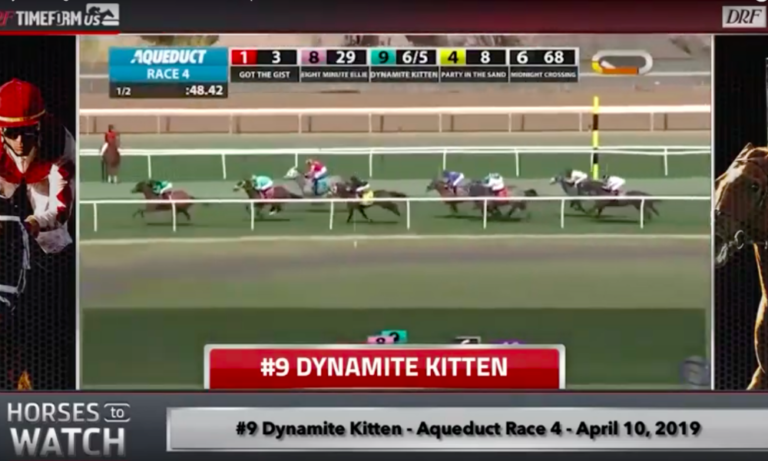LEXINGTON, Ky. – A group of tracks representing nearly 90 percent of the total handle on U.S. races, including all three hosts of the Triple Crown races, have agreed to seek a ban on the raceday use of the diuretic furosemide in all of their 2-year-old races beginning next year and then extend the ban to all of their stakes races in 2021, the group confirmed on Thursday morning.
The effort to implement the partial ban is being presented as a way to align U.S. racing regulations with most other racing jurisdictions around the world, where furosemide, which is more commonly known as Lasix, is generally banned on raceday in all races. Furosemide is legal to administer on raceday in North America to mitigate bleeding in the lungs, a common phenomenon in horses worldwide, but its use on raceday has split the North American racing industry into two increasingly combative camps and has served as a glaring target for critics of the sport.
The group, which hashed out the plan in the wake of intense scrutiny of the racing industry brought about by a spate of fatalities this winter at Santa Anita Park in Southern California, includes Aqueduct, Belmont, Churchill Downs, Del Mar, Fair Grounds, Gulfstream, Keeneland, Oaklawn, Pimlico, and Saratoga, along with a geographically diverse assortment of other major and minor tracks. In addition, the group has received the endorsement of the Breeders’ Cup, the Thoroughbred Owners and Breeders Association, and the American Graded Stakes Committee, an arm of TOBA.
“This is a progressive and unified approach to the subject of race day medication, achieving consistency with international standards for young horses and those that form the foundatons of our breeding stock,” said David O’Rourke, the chief executive officer of the New York Racing Association, which operates Aqueduct, Belmont, and Saratoga, in a release by the group.
The release said that the signees to the plan “will work diligently with their respective horsemen’s association and racing commissions toward implementing this effort.” Notably, the release did not say that the tracks would enforce the partial ban under so-called “house rules,” which are conditions of entry imposed by tracks that could be challenged in court.
Although the raceday use of furosemide has not been linked to equine fatalities, many critics of the racing industry, both inside and outside of the sport, seized on the Santa Anita deaths to renew calls to ban the drug on raceday, seeing the use of the medication as emblematic of an industry that many have criticized as being too cavalier about drug use. That led officials at Churchill Downs and the New York Racing Association, which host two of the three Triple Crown races, to search for a way to counter the criticism prior to the Kentucky Derby this year, when the eyes of the world are focused on U.S. racing, according to officials who participated in the discussions.
The Triple Crown is the U.S. racing industry’s most valuable asset, and it generates tens of millions of dollars for the tracks that host the races as well as relative fortunes for the owners and breeders of horses who win the races. The series also attracts millions of viewers and customers who are not regular racing fans, as well as the attention of national media outlets that rarely cover racing.
The use of Lasix on raceday has been an intense subject of controversy in the U.S. racing industry for decades, and the split over the issue has recently undermined efforts by some groups, such as The Jockey Club, to build support for federal legislation that would unify all 38 U.S. racing jurisdictions under a common set of rules enforced by a single entity. The legislation, which includes an explicit ban on raceday use of Lasix, has never advanced to a vote in Congress despite being introduced three times, but momentum behind the bill has been building, even as racetracks, for the most part, have quietly attempted to stay out of the fray, fearful of federal regulation.
In Kentucky, a group that represents rank-and-file horsemen, the Kentucky Horsemen’s Benevolent and Protective Association, has attempted to block previous raceday Lasix bans from being implemented at Kentucky tracks, arguing that because Kentucky’s racing rules state that it is legal to administer Lasix on raceday, a private company cannot ban the administration of the drug because it would take away a right already granted to horsemen under state law.
Marty Maline, the executive director of the KHBPA, said that Churchill officials met with horsemen on Wednesday and said that the company plans to “go through the regulatory process” to implement the partial ban.
“That would give the horsemen’s and veterinary communities the opportunity to air our concerns about safety and the fact that raceday Lasix is a beneficial treatment for the horse,” Maline said on Thursday morning. “I would expect that the commission would give it a fair airing.”
In New York, the president of the state’s horsemen’s group, Joe Appelbaum, released a statement shortly after the Thursday announcement defending the use of raceday Lasix.
“Furosemide has been a hot-button topic within horse racing for well over a decade, yet no one credibly believes that its use has an effect on breakdowns,” Appelbaum said. “The racetrack operators have stated that this is the first step in a continuing collaboration on safety and welfare issues. We hope this is just the beginning of a collaborative conversation.”
Eric Hamelback, the chief executive officer of the National HBPA, said on Thursday after the announcement that the association would be willing to sit down with other racing constituencies to discuss current rules on raceday Lasix use, but he also said that those discussions should include leaders of various veterinary groups, which have generally held that regulated use of Lasix on raceday is a humane treatment for horses that bleed, absent another effective treatment that has yet to be identified.
“We are always seeking and looking for whatever is in the best interests of the horse,” Hamelback said. “So we’re open to any suggestions that would further that. We just want to make sure that veterinary leadership is consulted.”
While U.S. racing is currently regulated on a state-by-state basis, state racing commissions are represented by an umbrella group, the Association of Racing Commissioners International, which develops model rules and recommends those rules for adoption. Ed Martin, the president of the RCI, said on Tuesday that his organization had not been involved in the discussions initiated by the tracks, but he said the group would welcome overtures to discuss the policy.
“We have a very divided and disjointed industry,” said Martin, in reference to the current Lasix policy. “It’s a matter of getting everyone in the same room and on the same page.”
In California, the company that owns Santa Anita Park and Golden Gate Fields, The Stronach Group, has already reached an agreement with a horsemen’s group, the Thoroughbred Owners of California, to phase out the raceday use of Lasix beginning with the foal crop of 2018, meaning that all 2-year-olds will race without Lasix next year at the tracks. The phase-out, which was applauded by animal-rights groups, will then follow that crop and all succeeding crops to race at the two tracks as they mature.
As a result of that existing agreement, the two California tracks owned by The Stronach Group have not committed to the new plan, but the other tracks owned by The Stronach Group, including Gulfstream Park in Florida and Laurel Park and Pimlico Race Course in Maryland, have endorsed the plan announced on Thursday. However, it is also possible the existing agreement in California is modified in the weeks or months ahead to conform to the new plan, given that California’s other major Thoroughbred tracks, Del Mar and Los Alamitos, were signees as well.
Many horsemen have expressed dissatisfaction with the latest efforts to ban the raceday use of the drug, contending that the use of medication is completely unrelated to catastrophic injuries and that supporters of the ban have exploited the deaths at Santa Anita to press an unpopular position. Just days after Santa Anita announced an indefinite shutdown of racing to examine its racing surface and its existing safety protocols, the federal legislation supported by The Jockey Club and other influential racing organizations was re-introduced to Congress, signaling to horsemen that supporters of the ban would use the crisis as an opportunity.
According to an official involved in the discussions, the tracks that have signed on to the plan agreed to the long lead-up prior to the stakes ban in order to give horsemen time to adjust to the changes. But they also are hoping that the long lead-up will also allow other tracks and racing organizations to endorse the effort and form a working group to address safety protocols that could be implemented by all members of the group as the measures are identified, the official said.
The official, who spoke on the condition of anonymity, said that the tracks involved in the effort were not acting under the belief that eliminating raceday furosemide would have an impact on catastrophic injury rates, but that the group believed that addressing a powerful target for horse racing critics could lead to progress on other fronts.
“I don’t think anyone is under the belief that this will eliminate breakdowns,” the official said. “But it does create some common ground for the group to move forward.”
The plan harkens back to other failed efforts in the U.S. racing industry to ban raceday Lasix use, at least in limited circumstances. In 2011, the American Graded Stakes Committee passed a rule that would have made any stakes race in the U.S. ineligible for a grade if Lasix was permitted pre-race, but the rule was rescinded when the committee did not get widespread buy-in from other racing constituencies. At the same time, the board of Breeders’ Cup Ltd. passed a rule banning raceday Lasix for its 2-year-old races and planned to extend the ban to all of its races in later years, but that rule was also rescinded just two years later.
This story originally appeared on DRF.com.
Visit DRF.com for additional news, notes, wagering information, and more.









